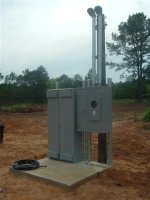fordmantpw
Veteran Member
I will preface my response by saying that my degree is in electrical engineering, though I don't practice (I'm a computer programmer instead). I remember many of the concepts from school 15+ years ago.
I will start off by saying that I don't think what you are wanting to do is going to be practical for you. I would be best handled by the electric company, as you need to deal with higher voltages. I am not doubting your skills, BTW, just thinking practically.
Essentially, the reason you have voltage and power drop in the line is due to the resistance in the line.
Power = Voltage * Current
Power Loss = Resistance * Current^2
You have to transmit the same amount of power, so if you double your voltage, you halve your current. Halving your current quarters your power loss. If you step the voltage up to 2200, your power loss is 1% of what it is at 220V. This is the reason electric companies run transmission lines of 100,000 volts +.
Now, to run it 750 feet, you are going to have a substantial drop in voltage, not to mention a lot of money spent just in the power loss of resistance of that line. Increasing the size of the wire decreases your resistance, therefore reducing your power loss and resultant voltage drop, but then the cost skyrockets. You could buy your own transformers and step your voltage yourself, but you really need an engineer to design and lay all of that out to do it correctly. You are better off just having the electric company do it. Electricity isn't something to play with, especially if you don't know what you are doing.
My recommendation would be to have the electric company put in a pad-mounted transformer close to where your building will be, running the supply to that transformer underground (this keeps the wires out of the trees and it looks much cleaner). They will put a meter right next to it, and you can run power to your building from that meter. Then, you could also come off of that meter and go to your deer blind (that's a fancy deer blind! ) where you could put a panel to run power on to your gazebo from there.
) where you could put a panel to run power on to your gazebo from there.
This is going to be the most efficient way to do it. Plus, all the power losses will be covered by the electric company and you won't be paying just to heat up the wires.
Best of luck in your planning. Whatever you do, I'm sure it will come out great, and I can't wait to follow it as with the lake build!
I will start off by saying that I don't think what you are wanting to do is going to be practical for you. I would be best handled by the electric company, as you need to deal with higher voltages. I am not doubting your skills, BTW, just thinking practically.
Essentially, the reason you have voltage and power drop in the line is due to the resistance in the line.
Power = Voltage * Current
Power Loss = Resistance * Current^2
You have to transmit the same amount of power, so if you double your voltage, you halve your current. Halving your current quarters your power loss. If you step the voltage up to 2200, your power loss is 1% of what it is at 220V. This is the reason electric companies run transmission lines of 100,000 volts +.
Now, to run it 750 feet, you are going to have a substantial drop in voltage, not to mention a lot of money spent just in the power loss of resistance of that line. Increasing the size of the wire decreases your resistance, therefore reducing your power loss and resultant voltage drop, but then the cost skyrockets. You could buy your own transformers and step your voltage yourself, but you really need an engineer to design and lay all of that out to do it correctly. You are better off just having the electric company do it. Electricity isn't something to play with, especially if you don't know what you are doing.
My recommendation would be to have the electric company put in a pad-mounted transformer close to where your building will be, running the supply to that transformer underground (this keeps the wires out of the trees and it looks much cleaner). They will put a meter right next to it, and you can run power to your building from that meter. Then, you could also come off of that meter and go to your deer blind (that's a fancy deer blind!
This is going to be the most efficient way to do it. Plus, all the power losses will be covered by the electric company and you won't be paying just to heat up the wires.
Best of luck in your planning. Whatever you do, I'm sure it will come out great, and I can't wait to follow it as with the lake build!


